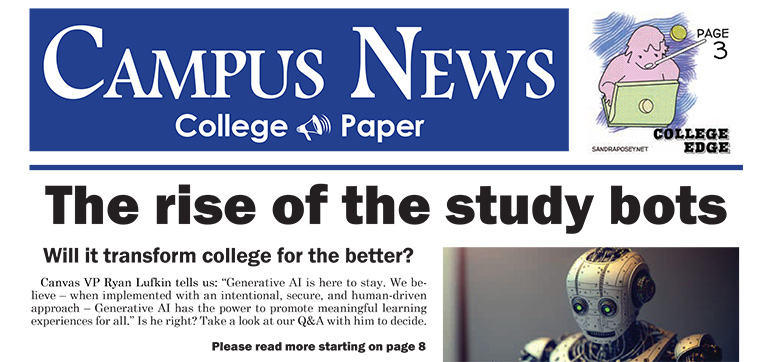By Darren Johnson
Campus News
As someone who also teaches college courses, along with running this higher-ed journal, I worry about the effects of our new AI revolution and how it will affect students and their learning.
I don’t want to seem reactionary. In fact, despite the fact that I own a couple of old-school print newspapers, I’ve worked hard to be on the forefront of technology and use it in my classes as well as teach best practices in its use for future journalists.
I’ve especially embraced the use of Canvas Learning Management System software for organizing my courses, and find it to be the best LMS out there by far. It has changed the way I teach, and my students respond well to its use.
But a lot is changing, and AI surely is affecting teaching and learning already.
I decided to hit up Canvas’ Ryan Lufkin for advice.
Ryan is no stranger to Campus News, as we interview him from time to time on matters related to education and digital technology.
He is the Global VP of Strategy at Instructure (makers of Canvas, the leading education technology used by schools across the country). He has been working with colleges and universities in the educational technology space for over 20 years, beginning with Utah-based start-up Campus Pipeline, the first html portal for higher education. He has worked for large ERP solutions like SungardHE and Ellucian helping evolve those systems to the Cloud, driven mobile adoption in teaching and learning technology, and developed curriculum for both corporate and higher education institutions. Ryan has helped lead Canvas’ evolution from an LMS to a full learning management platform to support the challenges facing colleges and universities of all sizes.
He holds a Bachelor of Science in Communication from the University of Utah and a Certificate in Data Driven Marketing from Cornell.
Here’s our recent e-chat:
Darren: Do you have any stats on how many college students are using AI to write their papers?
Ryan: While Instructure doesn’t have any specific stats, we did conduct a survey of just over 1,000 students, teachers and school administrators in both K-12 and post-secondary schools, in July and August of 2023.

Here are some of the results from that survey:
- Sentiment about AI is primarily positive with 54.5% of teachers, students and administrators feeling either very positive or positive. with 29.9% staying neutral.
- Respondents did feel like AI is “likely used sometimes” to cheat, but on the flip side, it can also help students understand their strengths and weaknesses. To some degree, respondents felt like AI overall was more helpful than harmful and even made them feel more confident.
- While more than 1/3 of respondents (41.7%) have not used AI. Those who had, however, were most familiar with OpenAI’s ChatGPT (30.6%).
- More than half, 56%, of respondents have not used AI for their schoolwork, but OpenAI’s ChatGPT was the choice for 23% of those who had used AI for their coursework.
- Teachers and students agree that cheating is the biggest risk of AI, with teachers ranking the concern higher than students.
- When ranking advantages of AI in the classroom, teachers actually view AI as an opportunity to avoid missing things, make learning fun and assist in generating answers. Students, on the other hand, appreciated that AI helps them avoid mistakes, avoid missing things and help generate answers.
- Teachers and administrators agree that both schools and the federal government must provide more guardrails when it comes to the use of AI in schools, especially when it comes to privacy laws.
- Teachers and traditional classroom instruction are not likely to be replaced by AI. Survey respondents stated they preferred human-led classes as opposed to AI-led options.
“The results of this survey show the majority of educators and students are beginning to see the benefits of generative in a classroom setting,” said Ryan Lufkin, vice president of global strategy at Instructure. “Used correctly, this transformative technology can elevate student success, empower educators and enhance the ways we teach and learn. When implemented with an intentional, secure and human-driven approach–generative AI has the power to save educators time and promote impactful learning experiences for all.”
Darren: How reliable are chat detection programs for professors? Many of us who teach don’t want to falsely accuse a student of using AI – perhaps a few of them actually do write like robots.
Ryan: Technology has transformed education over the years, especially with the emergence of Learning Management Systems like Canvas. Generative AI is here to stay. We believe–when implemented with an intentional, secure, and human-driven approach–Generative AI has the power to promote meaningful learning experiences for all.
We are committed to partnering with our customers and the edtech community at large to develop a positive and responsible approach to the use of AI. As such, we have created a full AI governance policy that focuses on three pillars:
- Transparency and accountability
- Bias and fairness
- Human-AI collaboration
Darren: How can we encourage students to write in their own words, or shouldn’t we?
Ryan: When it comes to using generative AI tools, students can utilize tools like ChatGPT to enhance their understanding of complex subjects or improve their writing skills:
- Personalized learning: ChatGPT can provide students with interactive, personalized learning experiences that can help them understand concepts and retain information better.
- Intelligent Tutoring: ChatGPT can act as an intelligent tutor, providing students with feedback and support as they work through problems and concepts. Its ability to generate human-like text can also be used to create engaging response content, such as interactive stories and flashcards.
- Content Generation: ChatGPT can be used to generate unique educational content by converting content from one modality like a written passage, into others like simulations or screenplays. It can also be used to create content that contrasts 2 opposing positions as a stimulus for learners to develop durable skills like critical thinking.
- Language Learning: ChatGPT can help non-native speakers improve their language skills through interactive conversations, and making content more accessible to them.
Darren: I believe many students don’t truly want to use chat programs – they just procrastinate and then feel rushed to do an assignment. Writing originally is harder than they imagine, perhaps. How can they not rely on AI as a “crutch” and time-manage better and aim for authenticity?
Ryan: Here are two examples of how some of Instructure’s customers are using generative I in their coursework:
- Some educators incorporate ChatGPT into their assignments by prompting it to write an essay on an assigned subject. They then have the class edit the paper to include sources or correct factual errors and omissions.
- Some educators have students use ChatGPT to build their initial outline and then have them build out the long-form content.
Darren Johnson teaches Journalism full-time as a visiting professor at a regional college. Reach him at editor@cccnews.info.







Facebook Comments